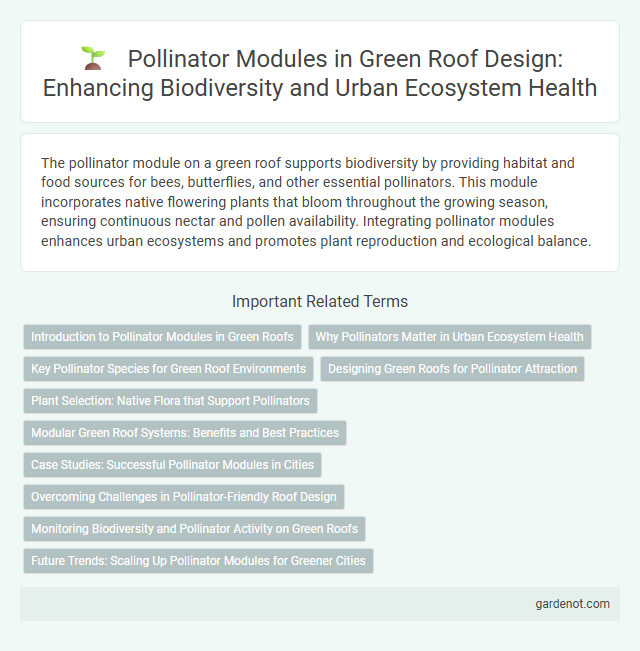The pollinator module on a green roof supports biodiversity by providing habitat and food sources for bees, butterflies, and other essential pollinators. This module incorporates native flowering plants that bloom throughout the growing season, ensuring continuous nectar and pollen availability. Integrating pollinator modules enhances urban ecosystems and promotes plant reproduction and ecological balance.
Introduction to Pollinator Modules in Green Roofs
Pollinator modules in green roofs create vital habitats that support bees, butterflies, and other pollinating insects essential for urban biodiversity and ecosystem health. These modules incorporate native flowering plants designed to attract and sustain pollinators, boosting urban green infrastructure's ecological function. Implementing pollinator-friendly vegetation in green roof systems enhances pollination services, contributing to increased plant diversity and improved urban environmental quality.
Why Pollinators Matter in Urban Ecosystem Health
Pollinators like bees, butterflies, and hummingbirds play a crucial role in urban ecosystem health by facilitating the reproduction of flowering plants, which enhances biodiversity and food security. Green roofs with pollinator modules create habitats that support these species, improving pollination efficiency and promoting urban green spaces. This biodiversity boost strengthens ecosystem resilience and contributes to cleaner air and improved microclimates in cities.
Key Pollinator Species for Green Roof Environments
Key pollinator species essential for green roof environments include native bees like the mason bee (Osmia spp.) and bumblebees (Bombus spp.), which are highly effective in urban green spaces due to their adaptability and foraging efficiency. Butterflies such as the monarch (Danaus plexippus) and moths also contribute to pollination by promoting biodiversity and supporting food webs. Incorporating a diverse range of flowering plants that bloom seasonally maximizes habitat suitability for these pollinators, enhancing ecosystem services on green roofs.
Designing Green Roofs for Pollinator Attraction
Designing green roofs for pollinator attraction requires selecting diverse native flowering plants that bloom across seasons to provide continuous nectar and pollen sources. Incorporating varying plant heights and structural complexity creates suitable habitats for different pollinator species, including bees, butterflies, and hoverflies. Using lightweight, well-draining soil substrates optimized for moisture retention supports healthy plant growth while ensuring the roof's structural integrity.
Plant Selection: Native Flora that Support Pollinators
Selecting native flora such as milkweed, coneflowers, and goldenrod enhances pollinator modules on green roofs by providing essential nectar and habitat for bees, butterflies, and other pollinators. These plants are well-adapted to local climate and soil conditions, ensuring higher survival rates and supporting biodiversity. Incorporating native species boosts ecosystem resilience and promotes the vitality of pollinator populations crucial for urban ecological balance.
Modular Green Roof Systems: Benefits and Best Practices
Modular green roof systems with pollinator modules provide essential habitats for bees, butterflies, and other beneficial insects, enhancing urban biodiversity and supporting ecosystem services. These systems improve stormwater management by capturing rainfall and reducing runoff while offering flexible installation and maintenance options. Implementing best practices such as selecting native, nectar-rich plants and ensuring appropriate module spacing maximizes pollination efficiency and promotes sustainable green infrastructure.
Case Studies: Successful Pollinator Modules in Cities
Urban green roofs incorporating pollinator modules have demonstrated significant biodiversity benefits, as seen in New York City's High Line project, which increased native bee populations by 30%. Chicago's City Hall green roof supported diverse pollinator species, enhancing local ecosystem services and improving urban crop yields within a 2-mile radius. Studies from Berlin highlight how modular pollinator habitats on green roofs contribute to regional pollinator corridors, promoting ecological connectivity in densely built environments.
Overcoming Challenges in Pollinator-Friendly Roof Design
Pollinator modules on green roofs tackle challenges such as limited space, harsh rooftop environments, and plant selection to support native pollinators effectively. Incorporating diverse, drought-resistant native plants with staggered bloom times enhances floral resources while minimizing maintenance needs. Strategic design integrating modular planting systems and microhabitats improves habitat connectivity and resilience for pollinator populations on urban roofs.
Monitoring Biodiversity and Pollinator Activity on Green Roofs
The Pollinator module on green roofs enhances monitoring biodiversity by tracking pollinator activity through advanced sensors and data analytics. It collects real-time information on species diversity, visitation frequency, and plant-pollinator interactions, supporting ecosystem health assessments. This data-driven approach optimizes green roof design for improved habitat value and pollination services in urban environments.
Future Trends: Scaling Up Pollinator Modules for Greener Cities
Pollinator modules are rapidly evolving as vital components in urban green roofing, enhancing biodiversity by supporting essential pollinator species such as bees and butterflies. Future trends emphasize scaling up these modules to integrated green infrastructure, aiming to create interconnected habitats that improve urban ecosystem services and mitigate environmental stressors. Innovations in modular design and plant selection optimize pollination efficiency, promoting sustainable, ecologically resilient cities worldwide.
Pollinator module Infographic

 gardenot.com
gardenot.com